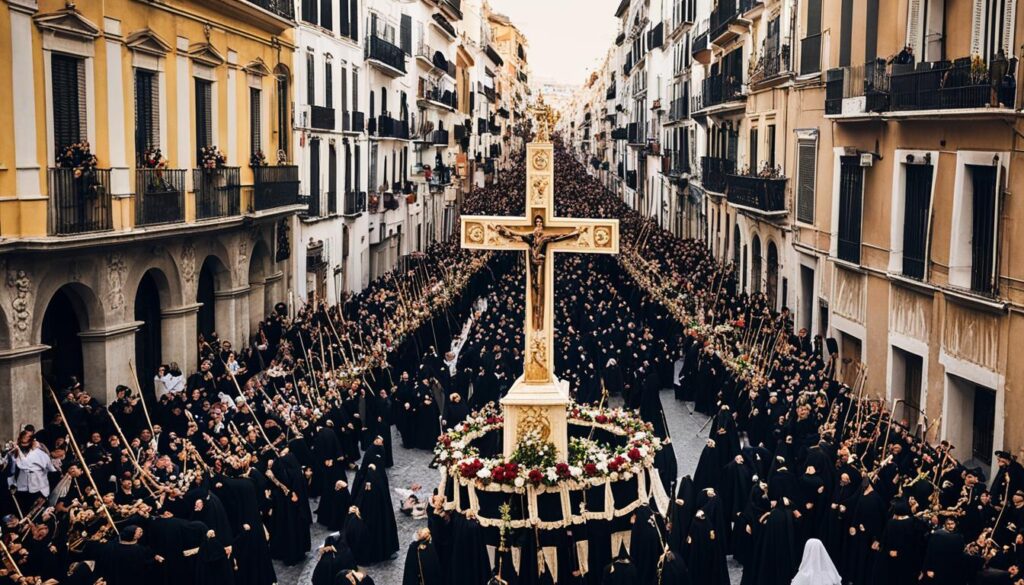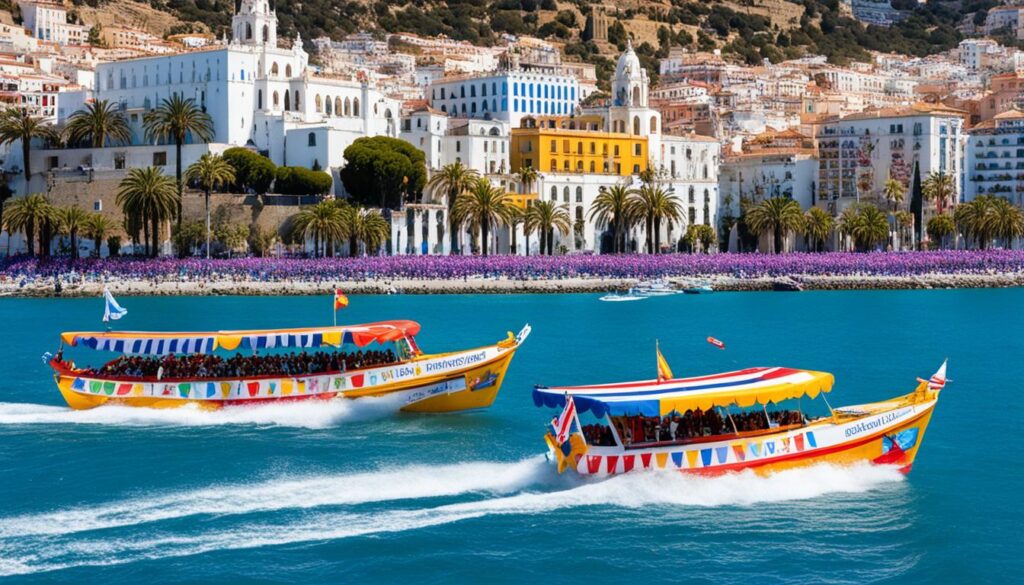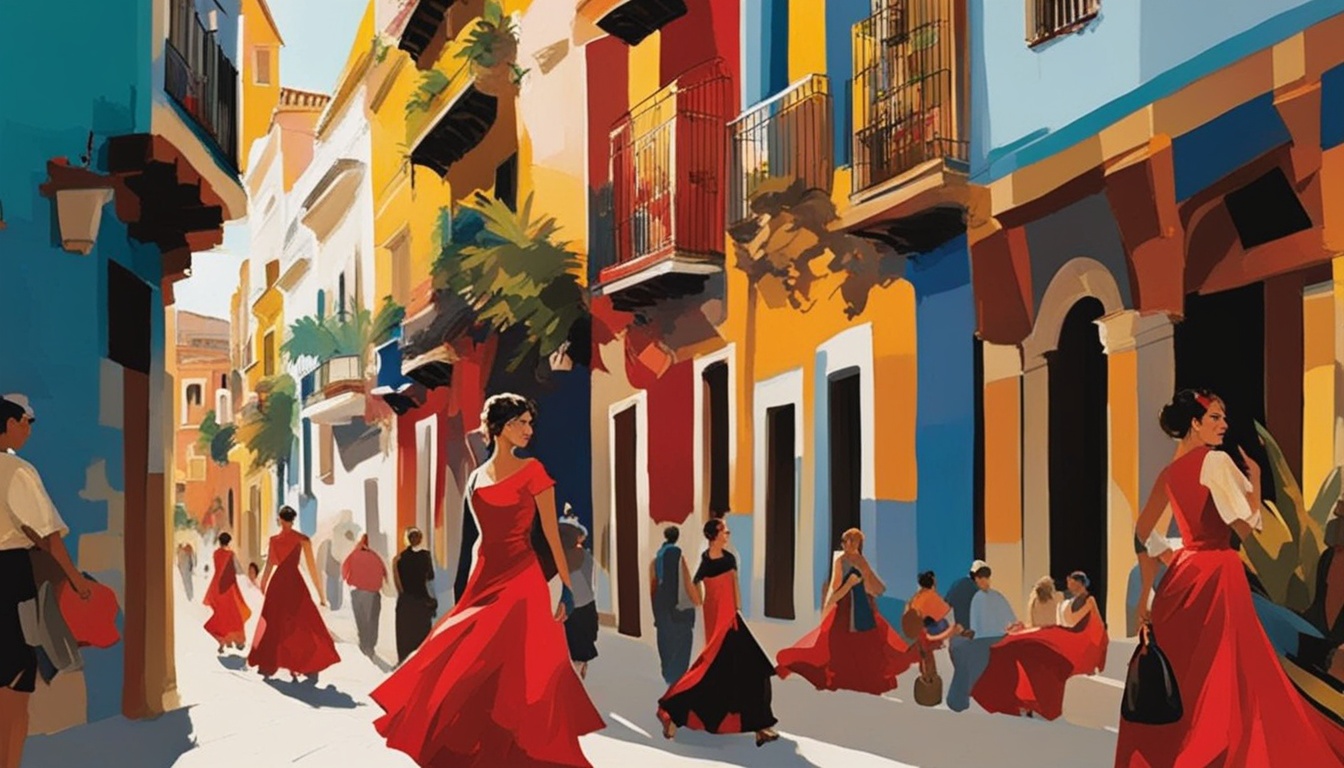Malaga sits on the stunning Costa del Sol in southern Spain. It’s a city full of life and culture, especially in spring. This season is perfect for diving into local traditions and the city’s unique vibe.
Malaga is packed with festivals and events that highlight its rich culture and modern art. You can enjoy everything from art shows to music concerts. It’s a place where history and art come together beautifully.
Malaga has something for everyone, whether you like theater, flamenco, or food. The city’s events calendar is full of activities that celebrate its Andalusian heritage. You can explore history or literature in a fun way.
This article will guide you through Malaga’s spring events. It will also suggest activities to make your visit unforgettable.
Key Takeaways
- Malaga is a vibrant cultural hub with a diverse range of festivals and events throughout the year
- Spring is an especially lively time, with celebrations showcasing the city’s Andalusian heritage and contemporary artistic scene
- Visitors can immerse themselves in Malaga’s Malaga cultural events, Malaga festivals, Malaga art exhibitions, and Malaga music concerts
- The city’s Malaga theater performances, Malaga flamenco shows, and Malaga culinary events offer unique insights into its rich cultural traditions
- Malaga’s Malaga historical reenactments and Malaga literary festivals provide opportunities to explore the city’s storied past and thriving creative community
Introduction to Malaga’s Cultural Richness
Malaga is a city on Spain’s sunny Costa del Sol. It beautifully mixes its Malaga cultural heritage with a lively Malaga modern culture. This city goes back to the Phoenicians and has left a lasting mark on its buildings and culture. You can see this in the Moorish Alcazaba fortress and the Roman Theatre, which show its rich Malaga history.
Malaga isn’t just about old landmarks. It has a lively Malaga cultural scene too. You’ll find a thriving arts scene, new foods, and many festivals. These events celebrate local traditions and customs. The University of Malaga is a key part of the city’s life, bringing together students from all over.
Malaga’s Blend of History and Modernity
Malaga’s history is clear in its architecture and culture. The Alcazaba fortress shows its Moorish past, while the Roman Theatre reminds us of its Roman roots. These old buildings sit alongside modern ones, making the city’s history and present come together beautifully.
The City’s Vibrant Cultural Scene
Malaga’s culture is full of different things to do. You can visit the Picasso Museum or the Centre Pompidou Malaga for art lovers. The city hosts events like the Malaga Film Festival and the Malaga Fair, celebrating Andalusian traditions.
The city’s food scene is just as exciting, with dishes like “espeto” and sweet Malaga wines. With lots of sunshine and a good cost of living, Malaga is perfect for students and visitors. This makes its culture lively and welcoming.
Malaga’s Iconic Festivals and Celebrations
Malaga is a vibrant city in southern Spain, known for its rich culture and lively celebrations. It has many festivals and events throughout the year. These events show off the city’s diverse culture and invite everyone to join in.
The Malaga Carnival is a big event in February and March. It’s a time of colorful parades, street bands, and masked performers. It’s a joyful way to celebrate the city’s spirit.
In April, Holy Week is a time of deep religious tradition. Fraternities carry huge floats through the streets. This shows the city’s strong faith and traditions.
Other key festivals include the Saint’s Day on June 16th and the Noche de San Juan on June 23rd. The Saint’s Day honors Saint Cyracious and Saint Paula. The Noche de San Juan involves burning puppets and fire-jumping to welcome summer.
The Malaga Feria in August is a 10-day event. It celebrates the city’s victory in 1487. Visitors can enjoy flamenco, sherry tastings, and a big firework show.
Malaga’s cultural events calendar is full of art, music, and more. These events let visitors dive into the city’s culture and feel its spirit.
| Event | Date | Highlights |
|---|---|---|
| Three Kings Celebration | January 5-6 | 12 festive processions and 5 bands participate |
| Malaga Carnival | February-March | Parades of costumed dancers, street bands, and mask-wearing performers |
| Holy Week (Semana Santa) | April | Fraternities carry floats weighing up to 5 tonnes across the city |
| Saint’s Day | June 16 | Festivities established since 1548, declared a holiday in 1582 |
| Noche de San Juan | June 23 | Burning of puppets, fire-jumping traditions to welcome the summer solstice |
| Malaga Feria | August | 10-day celebration with flamenco, sherry, and a firework display |
| Procession of the Virgin of Victory | September 8 | Procession from Nuestra Señora de la Victoria Church to the Town Hall |
| Picasso Month | October | Conferences, art exhibitions, concerts, and competitions |
| Verdiales Festival | December | Celebration of a lively flamenco dance style in the Olive region |
Malaga’s events calendar is full of things to do. It lets visitors experience the city’s culture and traditions up close.
Carnivals: A Colorful Celebration of Joy
Malaga is famous for its lively culture. Every year, it turns into a world of colors, music, and dance during the carnival. The Malaga Carnival is a big event, happening for a week in February before Shrove Tuesday. It’s a time for fun and celebration for everyone.
Carnival Traditions in Malaga
The Malaga Carnival has a long history, influenced by the Phoenicians, Romans, and Moors. It faced bans and restrictions but was revived in the 1980s. Now, it mixes old traditions with new ideas.
Highlights of Carnival Week
The Malaga Carnival 2024 will run from February 3rd to February 11th. It will be full of events that celebrate the city’s culture. Here are some top events:
- The Concurso de Agrupaciones, a big event that shows off the carnival’s talent and spirit.
- The Battle of the Flowers, a parade where groups compete with flowers and spirit.
- The Arrival of the Carnival King, which kicks off the carnival season and brings everyone together.
- The Parade of God Momo, which mixes old myths with modern fun.
- The Burial of the Boquerón, a fun event that marks the end of the carnival and the start of Lent.
During the carnival, Malaga buzzes with life. There are food stalls, live music, and street parties. It’s a great way to experience the city’s culture.
“The Malaga Carnival is a celebration of joy, where the city’s rich cultural heritage is on full display, captivating both locals and visitors alike.”
Holy Week: A Time of Solemn Reflection
In Malaga, Holy Week, or Semana Santa, is a key cultural event. It’s a tradition over 500 years old. It shows the deep faith and heritage of the Malaga people.
Malaga’s Semana Santa Processions
The main event of Semana Santa is the religious processions. Thousands watch as penitents in long robes carry floats. These floats show scenes from the Passion of Christ. Drums and trumpets add to the somber mood.
These processions start on Palm Sunday and end on Easter Sunday. The most moving events are on Maundy Thursday and Good Friday. Some floats are so heavy, over 5,000 kg, carried by 250 people. It shows the community’s dedication.
Passion Plays and Religious Traditions
Malaga also has Passion plays and other traditions. These give a glimpse into the city’s culture and faith. These events can go late into the night, offering a deep experience for all.
The Semana Santa in Malaga is a sight of faith and culture. It attracts visitors worldwide to see its traditions.

San Juan: Celebrating the Summer Solstice
On June 23rd, the sun sets over Malaga, and the city comes alive with the summer solstice celebration. This is the Noche de San Juan, a special night marking the longest day and the start of summer.
People gather at Malaga’s beautiful beaches for the fun. Bonfires light up the coast, making everything warm and cozy. The sound of music, laughter, and the bonfires fills the air.
Everyone jumps over the bonfires, a tradition to get rid of bad luck and welcome good fortune. This is a key part of the Malaga summer solstice celebrations.
The Malaga San Juan festival shows off the city’s rich culture. It’s a mix of old traditions and new, creating a strong sense of community.
As night goes on, the Malaga beach celebrations keep going. Everyone enjoys the festive mood, trying local foods, dancing, and making memories to remember.
“The Noche de San Juan in Malaga is a time-honored tradition that celebrates the essence of summer. It’s a chance for the community to come together, honor the rhythms of nature, and revel in the vibrant cultural tapestry of this remarkable city.”
Virgen del Carmen: Honoring the Patron Saint of Fishermen
In Malaga, the Virgen del Carmen is very important to the people. Every July, they celebrate her, the saint of fishermen and sailors. This festival shows the city’s strong link to the sea.
The Boat Procession Tradition
The boat procession is the main event of the festival. A special boat carries the Virgin Mary’s image. It’s followed by other boats along the coast.
People gather on the shore to watch. They come to honor the saint and enjoy this unique tradition.
Festivities and Local Culture
The festival is more than just the boat procession. It’s a celebration of Malaga’s fishing culture and community. There’s music, dances, and local food.
This shows off the city’s heritage and traditions. It’s a way to connect with Malaga’s coastal roots.
The festival honors the fishing industry’s role in Malaga’s economy. It celebrates the bond between the people and the sea. It’s a time to remember the city’s maritime spirit.

“The Virgen del Carmen celebrations in Malaga are a true embodiment of the city’s maritime heritage and the deep reverence its people hold for the sea and its protectors.”
Malaga’s Museums and Art Galleries
Malaga shows its love for the arts with its many museums and galleries. These places let visitors see the city’s rich culture and varied art. From the famous Picasso Museum to the modern Centre Pompidou Malaga, there’s a lot to see.
Picasso Museum: Birthplace of a Master
The Picasso Museum is in the place where Picasso was born. It lets visitors dive deep into the life and art of this famous Malaga artist. The museum is in the beautiful Buenavista Palace and shows how Picasso’s art changed over time.
Contemporary Art at Centre Pompidou Malaga
Malaga also has the Centre Pompidou Malaga, a branch of the famous Paris museum. This gallery shows modern art from both known and new artists. It offers exciting and deep art shows that show Malaga’s lively art scene.
These places, along with others, make Malaga a key spot for art lovers. People come from all over to see the city’s art.
Malaga has more than the Picasso Museum and Centre Pompidou Malaga. It has many museums and galleries that celebrate its culture and new art. You can find everything from the interactive Museo del Videojuego to the detailed Museo de Artes y Costumbres Populares.
Malaga’s museums and galleries show the city’s strong love for the arts. They invite visitors to see the different art and culture that make Malaga special.
Malaga cultural events
Malaga’s cultural events are a treat for everyone, offering a mix of art, music, and more. The city’s events showcase its deep history and lively creative spirit. There’s something for everyone, from art lovers to music fans.
Art Exhibitions and Music Festivals
Malaga’s museums and galleries feature amazing art exhibitions. You can see both classic and modern art that will amaze you. Don’t miss the famous Picasso Museum or the Centre Pompidou Malaga for the latest art trends.
Music is big in Malaga, with festivals for all kinds of music. You can enjoy traditional Andalusian tunes or modern hits. It’s a great way to experience the city’s vibrant culture.
Literary and Film Events
Malaga also celebrates literature and cinema. Book lovers can check out book fairs, talks with authors, and festivals. Film fans should look out for the Malaga Film Festival, which highlights Spanish and Latin American movies.
These events show Malaga’s love for the arts and its wish to share its culture with the world. No matter if you like art, music, books, or movies, Malaga has something special for you.
Culinary Delights: Malaga’s Gastronomic Scene
Malaga’s food scene shows off the city’s deep culture and fresh seafood. A must-try is the “espeto,” sardines grilled over an open flame by the beach. The city is also known for its sweet wine, a tradition from the Phoenicians.
Traditional Andalusian Cuisine
Modern chefs in Malaga are adding new twists to old Andalusian dishes. This makes the city a top spot for food lovers. Places like Restaurante José Carlos García and El Tintero offer unique dining experiences.
Los Marinos José, a family-owned seafood spot, has been serving tasty dishes for over 50 years. It draws both locals and visitors.
Malaga’s Renowned Sweet Wines
You can try Malaga’s sweet wines at the city’s bodegas and wine bars. These wines are often paired with local cheeses and meats. Food tours and cooking classes let you dive deeper into Malaga’s food traditions.
Malaga has dining options for every taste and budget. Whether it’s grilled sardines, traditional dishes, or sweet wines, Malaga’s food will impress you.
“Malaga’s culinary scene is a vibrant tapestry of flavors, reflecting the city’s rich cultural heritage and its abundance of fresh local produce.”
Historic Landmarks and Architecture
Malaga’s history is rich and full of landmarks and architectural wonders. At the center is the Alcazaba, a Moorish fortress from the 11th century. It sits on a hill, giving visitors amazing views of Malaga and the Mediterranean Sea.
Next to the Alcazaba, the Roman Theatre and the Gibralfaro Castle show the city’s cultural mix. The Roman Theatre, from the 1st century AD, was hidden until 1951. This shows the deep history of this ancient city.
The Alcazaba: A Moorish Fortress
The Alcazaba was once a Moorish palace-fortress. Built from 1057 to 1063, it’s a symbol of Malaga’s Islamic history. It held out against Catholic forces in 1487 for four months.
Roman Remnants and Gibralfaro Castle
The Roman Theatre and the Gibralfaro Castle add to Malaga’s cultural story. The Roman Theatre was found in 1951. The Gibralfaro Castle, from the 14th century, offers stunning views of the city and sea.
These landmarks and buildings take visitors on a journey through Malaga’s past. They show the city’s rich cultural heritage.
“The Alcazaba, a majestic Moorish fortress, stands as a testament to Malaga’s Islamic past, offering visitors breathtaking views of the city and the Mediterranean.”
Conclusion
Malaga is a city full of life and culture, perfect for travelers wanting to dive into southern Spain’s heart. It’s known for its exciting events and rich heritage. You’ll find everything from festivals to historical sites that show off local traditions.
Malaga has top museums, art galleries, and delicious food and wine. It’s a place where history meets modern life, making it a top spot for tourists. The city’s unique mix of old and new arts draws people from all over the world.
The city hosts many festivals, from carnivals to Holy Week, each one showing off Malaga’s culture. It also has historic sites like Moorish castles and Roman ruins. Malaga is ideal for those looking for a deep cultural experience or just a great vacation.

